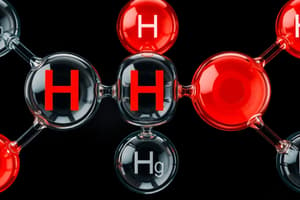Podcast
Questions and Answers
What observation indicates the presence of organic compounds when mixed with water?
What observation indicates the presence of organic compounds when mixed with water?
- The solution becomes cloudy.
- The temperature of the mixture increases.
- A color change occurs in the water.
- Two distinct layers form. (correct)
Which layer is denser when organic compounds are mixed with water?
Which layer is denser when organic compounds are mixed with water?
- Both layers have the same density.
- The upper layer, for organic materials.
- The layer with the least soluble substance.
- The lower layer, containing water. (correct)
Why do organic compounds form two layers when added to water?
Why do organic compounds form two layers when added to water?
- They are insoluble in water. (correct)
- They have a lower density than water.
- They react chemically with water.
- They have a higher vapor pressure.
How does the density of organic materials compare to that of water?
How does the density of organic materials compare to that of water?
What phenomenon can be used to differentiate between organic materials and water?
What phenomenon can be used to differentiate between organic materials and water?
Flashcards
Organic compounds and water
Organic compounds and water
These compounds don't mix with water.
Water's property
Water's property
It doesn't mix with substances like oil.
Organic layer
Organic layer
The layer on top when mixed with water.
Water layer
Water layer
Signup and view all the flashcards
Density
Density
Signup and view all the flashcards
Study Notes
Hydrocarbons
- Hydrocarbons are primarily composed of carbon and hydrogen.
- Alkanes have only single bonds.
- Alkenes have one or more carbon-carbon double bonds.
- Alkynes have one or more carbon-carbon triple bonds.
- Aromatic hydrocarbons have a circular pattern of alternating double and single bonds.
- Saturated hydrocarbons have no double or triple bonds (alkanes).
- Unsaturated hydrocarbons have double or triple bonds (alkenes, alkynes, and aromatics).
- Hydrocarbons have characteristic physical properties.
Volatility
- Hydrocarbons are generally nonpolar due to similar electronegativities of carbon and hydrogen (C=2.5, H=2.1).
- Minimal attraction between hydrocarbon molecules.
- Small hydrocarbons have low vaporization energies compared to larger ones.
- Therefore, small hydrocarbons are highly volatile.
Odor
- Volatility of hydrocarbons causes vaporization and transportation through air.
- Airborne hydrocarbon molecules reach the nose, producing characteristic odors.
- Many hydrocarbons have distinct smells.
Solubility
- Nonpolar nature of hydrocarbons leads to minimal attraction to other hydrocarbons.
- Hydrocarbons repel polar compounds like water.
Density
- Nonpolar hydrocarbons have weak intermolecular forces; they're loosely held together.
- Hydrocarbons have low densities.
- Polar compounds, conversely, have high densities due to strong intermolecular forces (e.g., hydrogen bonding in water).
Water Solubility Test
- Hydrocarbons are generally insoluble in water.
- Water's polarity strongly influences its ability to dissolve substances.
- Water forms two layers with organic compounds because of the difference in density.
Studying That Suits You
Use AI to generate personalized quizzes and flashcards to suit your learning preferences.




